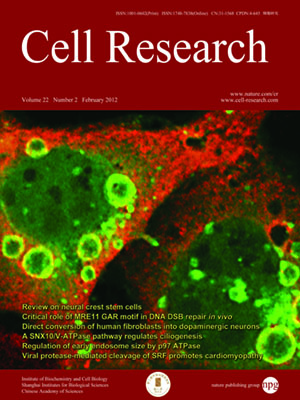
Volume 22, No 2, Feb 2012
ISSN: 1001-0602
EISSN: 1748-7838 2018
impact factor 17.848*
(Clarivate Analytics, 2019)
Volume 22 Issue 2, February 2012: 399-412
ORIGINAL ARTICLES
K-rasG12V transformation leads to mitochondrial dysfunction and a metabolic switch from oxidative phosphorylation to glycolysis
Yumin Hu1,2,*, Weiqin Lu2,*, Gang Chen2,*, Peng Wang1, Zhao Chen2, Yan Zhou2, Marcia Ogasawara2, Dunyaporn Trachootham2,3, Li Feng2, Helene Pelicano2,
1State Key Laboratory of Oncology in Southern China, Sun Yat-Sen University Cancer Center, Guangzhou 510275, China
2Department of Molecular Pathology, Unit 951, The University of Texas MD Anderson Cancer Center, 1515 Holcombe Boulevard, Houston, TX 77030, USA
3Faculty of Dentistry, Thammasat University, Pathum-thani 12121, Thailand
4Department of Surgical Oncology, The University of Texas MD Anderson Cancer Center, Houston, TX 77030, USA
5Department of Leukemia, The University of Texas MD Anderson Cancer Center, Houston, TX 77030, USA
Correspondence: Peng Huang,(phuang@mdanderson.org)
Increased aerobic glycolysis and oxidative stress are important features of cancer cell metabolism, but the underlying biochemical and molecular mechanisms remain elusive. Using a tetracycline inducible model, we show that activation of K-ras
G12V causes mitochondrial dysfunction, leading to decreased respiration, elevated glycolysis, and increased generation of reactive oxygen species. The K-RAS protein is associated with mitochondria, and induces a rapid suppression of respiratory chain complex-I and a decrease in mitochondrial transmembrane potential by affecting the cyclosporin-sensitive permeability transition pore. Furthermore, pre-induction of K-ras
G12V expression
in vitro to allow metabolic adaptation to high glycolytic metabolism enhances the ability of the transformed cells to form tumor
in vivo. Our study suggests that induction of mitochondrial dysfunction is an important mechanism by which K-ras
G12V causes metabolic changes and ROS stress in cancer cells, and promotes tumor development.
Cell Research (2012) 22:399-412. doi:10.1038/cr.2011.145; published online 30 August 2011
FULL TEXT | PDF
Browse 2384


